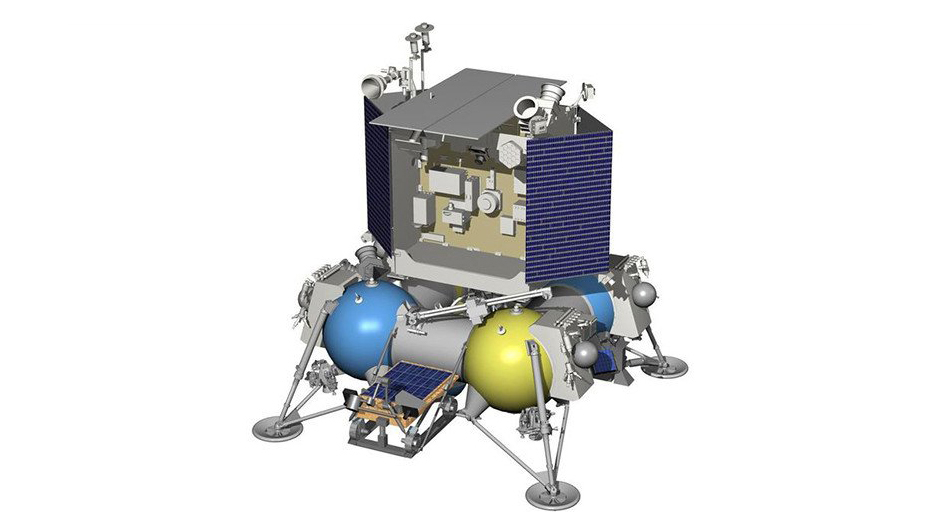Europe halts moon exploration partnership with Russia, looks to replace Ukraine-built rocket engines
Russia's space partnerships continue to splinter.

The European Space Agency will discontinue its cooperation on Russia's Luna series of robotic moon missions, ESA officials announced Wednesday (April 13).
The development is part of ESA's effort to disentangle itself from a web of partnerships with Russia in the wake of the latter's invasion of neighboring Ukraine.
ESA's decision goes into effect immediately. For example, the agency has requested that its Pilot D landing camera be taken off the Luna 25 mission, which is scheduled to launch later this year.
"I have already communicated this decision to the head of Roscosmos and requested that [Pilot D] is put in safe storage until it can be returned to ESA," ESA's director general Josef Aschbacher said in an online news conference on Wednesday (April 13). (Roscosmos is Russia's federal space agency; it's led by Dmitry Rogozin.)
ESA's director of human and robotic exploration, David Parker, added that removing the instrument will have no effect on Russia's ability to conduct the mission.
"It's not part of the operational spacecraft system," Parker said.
Related: Russia's invasion of Ukraine as seen in satellite photos
Get the Space.com Newsletter
Breaking space news, the latest updates on rocket launches, skywatching events and more!
ESA has also been cooperating on Russia's follow-up moon missions, Luna 26 and Luna 27. That work, too, has now been suspended. The Luna 27 rover, planned for 2025, was expected to feature a Europe-built optical navigation system relying on artificially intelligent image analysis, and a subsurface drill designed to obtain samples of lunar soil from depths of up to 3 feet (1 meter).
ESA, Aschbacher said, is already negotiating alternatives to deliver these technologies to the moon.
The drill, Aschbacher said, will fly to the moon with NASA as part of the American agency's Commercial Lunar Payload Services program.
At the news conference, ESA also discussed the future of its small Vega rocket, which relies on Ukraine-built engines in its upper stage. The engines are manufactured by the Ukrainian company Yuzhmash, which is based in the tech city of Dnipro. Although Dnipro has been under heavy bombardment, there have been no official reports so far about damage to Yuzhmash. It is, however, clear that ESA doesn't expect to continue its partnership with the company in the future.
"We now have sufficient engines for 2022 and 2023," Aschbacher said. "We are working on options for 2024 and onwards based on different technologies."
Daniel Neuenschwander, ESA's director of space transportation, added: "We are working on engine opportunities within Europe and outside of Europe, which are either tested or, even better, already existing and fully qualified."
ESA previously suspended cooperation with Russia on the ExoMars rover mission, which was expected to launch on Russia's Proton rocket from the Baikonur Cosmodrome in Kazakhstan in September. In addition to the rocket, the mission also featured a Russian-built landing platform.
Aschbacher said the agency is now conducting a series of studies to evaluate the possible ways forward for ExoMars without Russia. Results of these studies will be presented to ESA member states in July. As all of the alternatives are bound to come with extra cost, the member states will have to decide about the rover's future.
Originally planned for 2018, the launch of the ExoMars rover faced several delays because of problems with its landing parachutes, and, subsequently, the COVID-19 pandemic. The rover, fitted with a 6-foot-long (2 m) drill, was designed to search for traces of past and present life underneath the surface of the Red Planet.
A commercial collaboration between European launch provider Arianespace and Russia ended shortly after the beginning of the war in Ukraine when Roscosmos withdrew its personnel from Europe's cosmodrome in Kourou, French Guiana, and canceled several planned launches of its Soyuz rockets. The move was a response to the wide-ranging western sanctions against Russia.
Arianespace had been using Soyuz rockets since 2011 to complement its light-weight Vega and heavy-lift Ariane 5 launchers.
Follow Tereza Pultarova on Twitter @TerezaPultarova. Follow us on Twitter @Spacedotcom and on Facebook.
Join our Space Forums to keep talking space on the latest missions, night sky and more! And if you have a news tip, correction or comment, let us know at: community@space.com.

Tereza is a London-based science and technology journalist, aspiring fiction writer and amateur gymnast. Originally from Prague, the Czech Republic, she spent the first seven years of her career working as a reporter, script-writer and presenter for various TV programmes of the Czech Public Service Television. She later took a career break to pursue further education and added a Master's in Science from the International Space University, France, to her Bachelor's in Journalism and Master's in Cultural Anthropology from Prague's Charles University. She worked as a reporter at the Engineering and Technology magazine, freelanced for a range of publications including Live Science, Space.com, Professional Engineering, Via Satellite and Space News and served as a maternity cover science editor at the European Space Agency.









